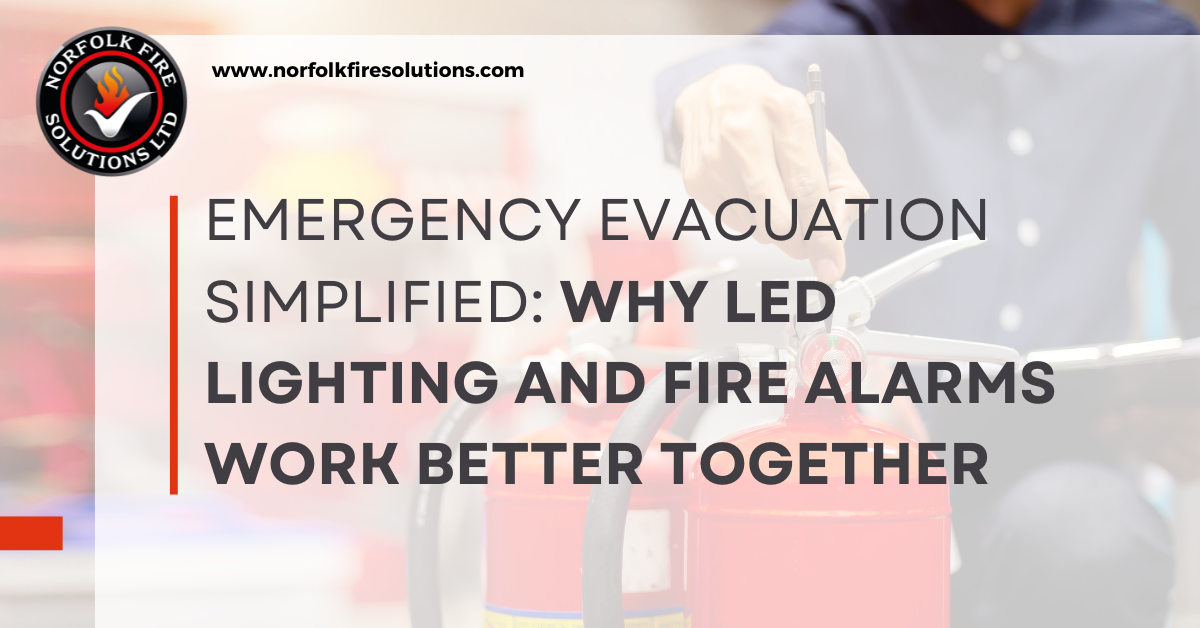Emergency Evacuation Simplified: Why LED Lighting and Fire Alarms Work Better Together
Emergency Evacuation Simplified: Why LED Lighting and Fire Alarms Work Better Together

In emergencies, every second matters. Fire alarm systems alert occupants to danger, but effective evacuation depends on more than just sound—clear visibility is critical, and that’s where LED emergency lighting comes into play. When these two systems work together, they form a powerful duo that not only warns but also guides people to safety.
In this post, we’ll explore how LED emergency lighting and fire alarms complement each other, creating a robust evacuation system that protects lives and ensures compliance with UK fire safety regulations.
The Role of Fire Alarms: Sounding the Alarm
Fire alarms are the first line of defence in any fire safety plan. They serve two critical functions:
- Alert Occupants: Loud alarms notify everyone in the building of a fire, giving them time to act.
- Signal Evacuation: Fire alarms trigger emergency responses, including activating fire doors and emergency lighting systems.
Limitations of Fire Alarms Alone
While fire alarms are effective at alerting people, they cannot guide them to safety. Smoke, darkness, and confusion during emergencies can disorient occupants, especially in large or complex buildings.
The Role of LED Emergency Lighting: Lighting the Way
LED emergency lighting ensures visibility during an evacuation, particularly when normal lighting systems fail due to fire or power outages. It provides illumination for:
- Escape routes: Highlighting pathways to safety.
- Exit points: Clearly marking doors and safe zones.
- Staircases and intersections: Avoiding obstacles and ensuring safe movement.
- Assembly points: Lighting outdoor areas for post-evacuation safety.
Key Advantages of LED Emergency Lighting
- Long-Lasting Performance: LEDs provide reliable light for at least several hours during a power outage, as required by UK standards.
- Energy Efficiency: They consume less power and are cost-effective to maintain.
- High Visibility: Bright, focused lighting ensures occupants can see through smoke or darkness.
How Fire Alarms and LED Emergency Lighting Work Together
When integrated, fire alarms and LED emergency lighting form a unified evacuation system that enhances safety and efficiency. Here’s how they work together:
1. Simultaneous Activation
Fire alarms trigger LED emergency lights as soon as an emergency is detected. This ensures that escape routes are illuminated from the moment the alarm sounds.
2. Complementary Guidance
- Fire alarms provide audible alerts, while LED lighting offers visual guidance. Together, they cater to different sensory needs, ensuring accessibility for all occupants, including those with hearing or visual impairments.
- Example: In a hospital, alarms notify staff and patients, while LED emergency lighting ensures that corridors, stairwells, and operating rooms are clearly lit for safe evacuation.
3. Enhanced Safety
- LED lighting highlights fire extinguishers, call points, and safety equipment, enabling quicker responses to small fires.
- Alarms and lighting systems work together to ensure a structured and panic-free evacuation.
Why Integration Matters
Compliance with UK Regulations
The Regulatory Reform (Fire Safety) Order 2005 requires businesses to implement adequate fire alarm and emergency lighting systems. Emergency lighting must meet BS 5266, while fire alarms must comply with BS 5839. Integrated systems ensure full compliance, reducing the risk of penalties or enforcement action.
Better Preparedness
Integrated systems are easier to maintain and test, ensuring they function properly when needed. Regular drills with both alarms and lighting help employees become familiar with evacuation procedures.
Tips for Creating an Integrated System
- Conduct a Fire Risk Assessment: Identify areas that require both fire alarms and LED emergency lighting, such as escape routes, staircases, and high-risk zones.
- Invest in Quality Systems: Choose fire alarms and LED emergency lights that meet UK standards and are compatible for seamless integration.
- Consult Professionals: Work with qualified fire safety specialists to design and install a system tailored to your premises.
- Test Regularly: Conduct monthly tests to ensure both systems activate as intended during emergencies.
- Train Employees: Provide fire safety training that includes understanding how alarms and lighting work together.
Conclusion
Fire alarms and LED emergency lighting are not just standalone systems, they are complementary tools that together create a comprehensive fire safety solution. While alarms alert and warn, LED lighting guides and reassures, ensuring that every occupant has the best chance of a safe evacuation.
By integrating these systems and maintaining them regularly, businesses can protect lives, meet legal requirements, and demonstrate their commitment to safety. Don’t leave evacuation to chance, pair fire alarms with LED emergency lighting for a safer, more effective response to emergencies.
